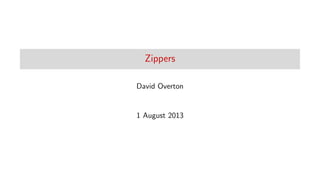The document discusses zippers, which are data structures that help navigate and update immutable data structures efficiently. It introduces list and tree zippers, demonstrating their utility with examples such as Haskell implementations for window managers and XML navigation. The conclusion highlights the usefulness of zippers in functional programming, the algebraic nature of data types, and the potential for deriving zippers through type differentiation.


![Motivation
Navigating around in and updating mutable data structures is easy:
• Keep a pointer to your current location in the data structure;
• Update the pointer to move around the data structure;
• Modify the data structure using destructive update via the pointer.
Example (C Array)
char my_array[1024];
char *p = my_array;
// Move right
p++;
// Move left
p--;
// Update focused element
*p = ’A’;](https://image.slidesharecdn.com/91rtjndetacdhhesom1j-140525212750-phpapp02/85/Zippers-3-320.jpg)
![Motivation
But what is the equivalent for an immutable data structure? I.e. how do we keep track
of a local focus point within a data structure? E.g. XML document tree, text editor
buffer, window manager stack (e.g. XMonad), AVL tree.
For a list we could use an integer to represent the element we are interested in:
type ListFocus a = (Int, [a])
but this requires traversing from the start of the list every time – an O(n) operation.
For more complex types, this is even less practical.
Instead, we can use a data structure called a zipper.](https://image.slidesharecdn.com/91rtjndetacdhhesom1j-140525212750-phpapp02/85/Zippers-4-320.jpg)

![List Zipper
-- A list zipper is a pair consisting of the front
-- of the list (reversed) and the rear of the list.
type ListZipper a = ([a], [a])
-- Convert a list to a zipper.
-- Start at the front of the list.
fromList :: [a] → ListZipper a
fromList xs = ([], xs)](https://image.slidesharecdn.com/91rtjndetacdhhesom1j-140525212750-phpapp02/85/Zippers-6-320.jpg)
![List Zipper
-- Move about in the zipper.
right, left :: ListZipper a → ListZipper a
right (xs, y:ys) = (y:xs, ys)
left (x:xs, ys) = (xs, x:ys)
-- Modify the focused element.
modify :: (a → a) → ListZipper a → ListZipper a
modify f (xs, y:ys) = (xs, (f y):ys)
modify _ zs = zs
-- When we are finished, convert back to a list.
toList :: ListZipper a → [a]
toList ([], ys) = ys
toList zs = toList (left zs)](https://image.slidesharecdn.com/91rtjndetacdhhesom1j-140525212750-phpapp02/85/Zippers-7-320.jpg)
![*Main> let z = fromList [’a’, ’b’, ’c’]
*Main> z
("","abc")
a
ctx list
b
c](https://image.slidesharecdn.com/91rtjndetacdhhesom1j-140525212750-phpapp02/85/Zippers-8-320.jpg)





![Binary Tree
data Tree a
= Empty
| Node (Tree a) a (Tree a)
deriving Show
type Context a = Either (a, Tree a) (a, Tree a)
type TreeZipper a = ([Context a], Tree a)
fromTree :: Tree a → TreeZipper a
fromTree t = ([], t)
right, left, up :: TreeZipper a → TreeZipper a
right (ctx, Node l a r) = (Right (a, l) : ctx, r)
left (ctx, Node l a r) = (Left (a, r) : ctx, l)](https://image.slidesharecdn.com/91rtjndetacdhhesom1j-140525212750-phpapp02/85/Zippers-14-320.jpg)
![Binary Tree
up (Left (a, r) : ctx, l) = (ctx, Node l a r)
up (Right (a, l) : ctx, r) = (ctx, Node l a r)
modify :: (a → a) → TreeZipper a → TreeZipper a
modify f (ctx, Node l a r) = (ctx, Node l (f a) r)
modify f z = z
toTree :: TreeZipper a → Tree a
toTree ([], t) = t
toTree z = toTree (up z)](https://image.slidesharecdn.com/91rtjndetacdhhesom1j-140525212750-phpapp02/85/Zippers-15-320.jpg)

![*Main> right $ fromTree t
( [Right (’a’,
Node
(Node Empty ’d’ Empty)
’b’
(Node Empty ’e’ Empty))],
Node
(Node Empty ’f’ Empty)
’c’
(Node Empty ’g’ Empty) )
Right
a c
b
ed
gf
ctx tree](https://image.slidesharecdn.com/91rtjndetacdhhesom1j-140525212750-phpapp02/85/Zippers-17-320.jpg)
![*Main> left $ right $ fromTree t
( [ Left (’c’, Node Empty ’g’ Empty),
Right (’a’,
Node
(Node Empty ’d’ Empty)
’b’
(Node Empty ’e’ Empty))],
Node Empty ’f’ Empty )
Right
Left
a
c
b
ed
g
f
ctx tree](https://image.slidesharecdn.com/91rtjndetacdhhesom1j-140525212750-phpapp02/85/Zippers-18-320.jpg)
![Tree Zippers
Example (XML)
• XPath navigation around an XML document is basically a zipper – you have a
current context and methods to navigate to neighbouring nodes.
• One implementation of this in Haskell is the rose tree zipper from HXT.
data NTree a = NTree a [NTree a] -- A rose tree
data NTCrumb = NTC [NTree a] a [NTree a] -- "Breadcrumb" for context
-- The zipper itself
data NTZipper a = NTZ { ntree :: NTree a, context :: [NTCrumb a] }
-- And using it to represent XML
type XmlTree = NTree XNode
type XmlNavTree = NTZipper XNode
data XNode = XText String | XTag QName [XmlTree] | XAttr QName | · · ·](https://image.slidesharecdn.com/91rtjndetacdhhesom1j-140525212750-phpapp02/85/Zippers-19-320.jpg)









![List Zipper
L(a) =
1
1 − a
∂aL(a) =
1
(1 − a)2
= L(a)2
ZL(a) = a.∂aL(a) = a.L(a)2
type ListZipper a = (a, [a], [a])
This is slightly different from our original list zipper type ([a], [a]). The
distinguished element is now pulled out of the second list and made explicit. This also
means that the zipper can’t be empty. However, this is still a list zipper and we derived
it using the differential calculus!](https://image.slidesharecdn.com/91rtjndetacdhhesom1j-140525212750-phpapp02/85/Zippers-29-320.jpg)
![Tree Zipper
T(a) = 1 + a.T(a)2
∂aT(a) = T(a)2 + 2a.T(a).∂aT(a)
∂aT(a) =
T(a)2
1 − 2a.T(a)
= T(a)2.L(2a.T(a))
ZT (a) = a.∂aT(a)
= a.T(a)2.L(2a.T(a))
type Context a = Either (a, Tree a) (a, Tree a)
type TreeZipper a = (a, Tree a, Tree a, [Context a])](https://image.slidesharecdn.com/91rtjndetacdhhesom1j-140525212750-phpapp02/85/Zippers-30-320.jpg)

